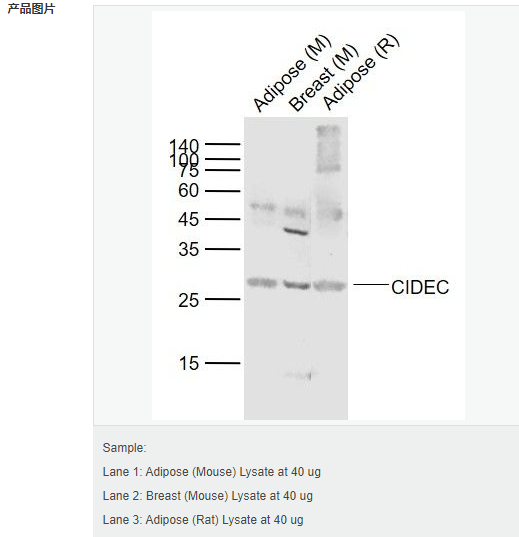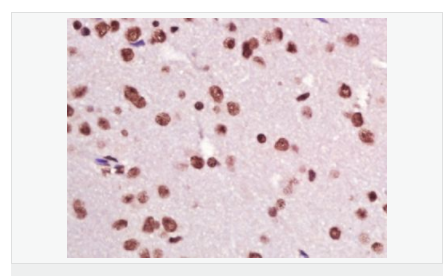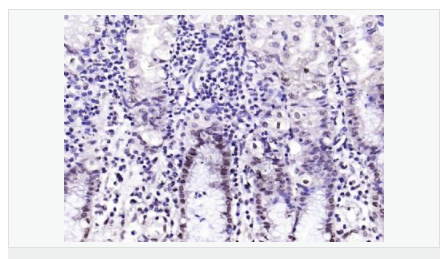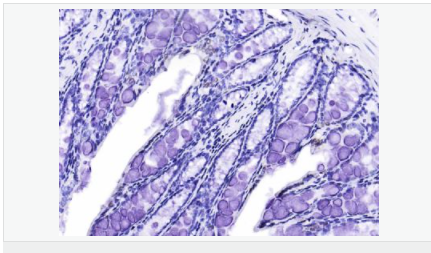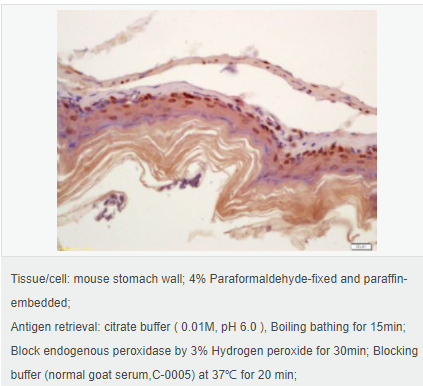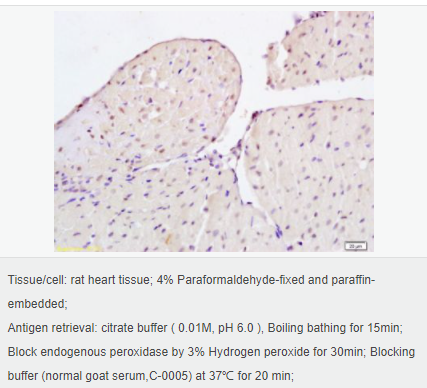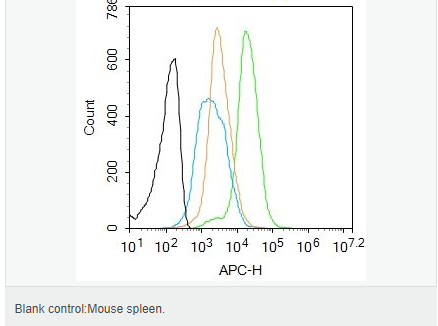

貨號
產(chǎn)品規(guī)格
售價(jià)
備注
BN41952R-50ul
50ul
¥1486.00
交叉反應(yīng):Human,Mouse,Rat(predicted:Pig) 推薦應(yīng)用:WB,IHC-P,IHC-F,IF,Flow-Cyt,ELISA
BN41952R-100ul
100ul
¥2360.00
交叉反應(yīng):Human,Mouse,Rat(predicted:Pig) 推薦應(yīng)用:WB,IHC-P,IHC-F,IF,Flow-Cyt,ELISA
BN41952R-200ul
200ul
¥3490.00
交叉反應(yīng):Human,Mouse,Rat(predicted:Pig) 推薦應(yīng)用:WB,IHC-P,IHC-F,IF,Flow-Cyt,ELISA
產(chǎn)品描述
| 英文名稱 | CIDEC |
| 中文名稱 | 細(xì)胞死亡活化蛋白抗體 |
| 別 名 | Cell Death Activator; Cell death activator CIDE-3; Cell Death Inducing DFFA Like Effector C; Cell death inducing DFFA like effector protein C; Cell death-inducing DFFA-like effector protein C; CIDE 3; CIDE3; CIDE C; CIDEC_HUMAN; Fat specific protein 27; Fat-specific protein FSP27 homolog; FLJ20871; FSP27. |
| 研究領(lǐng)域 | 腫瘤 心血管 細(xì)胞生物 免疫學(xué) 信號轉(zhuǎn)導(dǎo) 細(xì)胞凋亡 表觀遺傳學(xué) |
| 抗體來源 | Rabbit |
| 克隆類型 | Polyclonal |
| 交叉反應(yīng) | Human, Mouse, Rat, (predicted: Pig, ) |
| 產(chǎn)品應(yīng)用 | WB=1:500-2000 ELISA=1:5000-10000 IHC-P=1:100-500 IHC-F=1:100-500 Flow-Cyt=2ug/Test IF=1:100-500 (石蠟切片需做抗原修復(fù)) not yet tested in other applications. optimal dilutions/concentrations should be determined by the end user. |
| 分 子 量 | 27kDa |
| 細(xì)胞定位 | 細(xì)胞核 細(xì)胞漿 |
| 性 狀 | Liquid |
| 濃 度 | 1mg/ml |
| 免 疫 原 | KLH conjugated synthetic peptide derived from human CIDEC:101-200/238 |
| 亞 型 | IgG |
| 純化方法 | affinity purified by Protein A |
| 儲 存 液 | 0.01M TBS(pH7.4) with 1% BSA, 0.03% Proclin300 and 50% Glycerol. |
| 保存條件 | Shipped at 4℃. Store at -20 °C for one year. Avoid repeated freeze/thaw cycles. |
| PubMed | PubMed |
| 產(chǎn)品介紹 | This gene encodes a member of the cell death-inducing DNA fragmentation factor-like effector family. Members of this family play important roles in apoptosis. The encoded protein promotes lipid droplet formation in adipocytes and may mediate adipocyte apoptosis. This gene is regulated by insulin and its expression is positively correlated with insulin sensitivity. Mutations in this gene may contribute to insulin resistant diabetes. A pseudogene of this gene is located on the short arm of chromosome 3. Alternatively spliced transcript variants that encode different isoforms have been observed for this gene. [provided by RefSeq, Dec 2010]. Tissue specificity: Expressed mainly in small intestine, heart, colon and stomach and, at lower levels, in brain, kidney and liver. Function: May act as a CEBPB coactivator in white adipose tissueto control the expression of a subset of CEBPB downstream targetgenes, including SOCS1, SOCS3, TGFB1, TGFBR1, ID2 and XDH (Bysimilarity). Binds to lipid droplets and regulates theirenlargement, thereby restricting lipolysis and favoring storage. Atfocal contact sites between lipid droplets, promotes directionalnet neutral lipid transfer from the smaller to larger lipiddroplets. The transfer direction may be driven by the internalpressure difference between the contacting lipid droplet pair. Whenoverexpressed in preadipocytes, induces apoptosis or increases cellsusceptibility to apoptosis induced by serum deprivation or TGFBtreatment. As mature adipocytes, that express high CIDEC levels,are quite resistant to apoptotic stimuli, the physiologicalsignificance of its role in apoptosis is unclear. Subunit: Interacts with CEBPB (By similarity). Interacts withCIDEA. Subcellular Location: Nucleus (By similarity). Endoplasmicreticulum (By similarity). Lipid droplet. Note=Diffuses quickly onlipid droplet surface, but becomes trapped and clustered at lipiddroplet contact sites, thereby enabling its rapid enrichment atlipid droplet contact sites. Tissue Specificity: Expressed mainly in adipose tissue, smallintestine, heart, colon and stomach and, at lower levels, in brain,kidney and liver. Post-translational modifications: Ubiquitinated and targeted to proteasomal degradation,resulting in a short half-life. Protein stability depends ontriaclyglycerol synthesis, fatty acid availability and lipiddroplet formation (By similarity). DISEASE: Note=In omental adipose tissue of obese patients matchedfor BMI, expression levels tend to correlate with insulinsensitivity. Expression is increased 2-3 fold in the group ofpatients with high insulin sensitivity, compared to theinsulin-resistant group. This observation is consistent with theidea that triglyceride storage in adipocytes plays an importantrole in sequestering triglycerides and fatty acids away from thecirculation and peripheral tissues, thus enhancing insulinsensitivity in liver and muscle. This effect is not significant insubcutaneous adipose tissue (PubMed:18509062). In subcutaneousadipose tissue of diabetic patients, tends to negatively correlatewith body mass index and total fat mass, independently of insulinsensitivity (PubMed:18334488). Similarity: Contains 1 CIDE-N domain. SWISS: Q96AQ7 Gene ID: 63924 Database links: Entrez Gene: 63924 Human Entrez Gene: 14311 Mouse Omim: 612120 Human SwissProt: Q96AQ7 Human SwissProt: P56198 Mouse Unigene: 567562 Human Unigene: 635072 Human Unigene: 10026 Mouse Unigene: 33794 Rat Important Note: This product as supplied is intended for research use only, not for use in human, therapeutic or diagnostic applications. |
